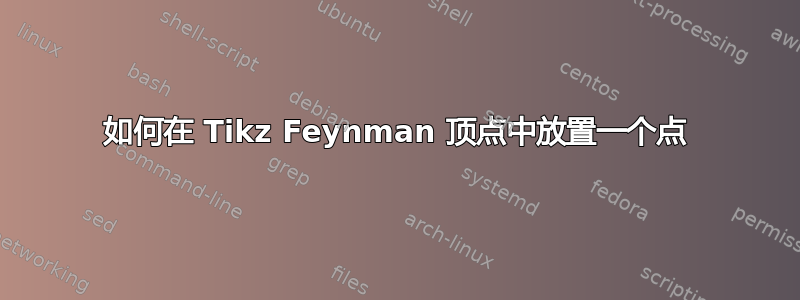
我写了这段代码
\begin{tikzpicture}
\begin{feynman}
\vertex (a1) {\(\overline b\)};
\vertex[right=1.5cm of a1] (a2);
\vertex[right=1.5cm of a2] (a3);
\vertex[right=2cm of a1] (aa);
\vertex[right=2cm of aa] (a4) {\(\overline{s}\)};
\vertex[below=1cm of a1] (b1) {\(s\)};
\vertex[right=2cm of b1] (b2);
\vertex[right=2cm of b2] (b3) {\(s\)};
\vertex[above=1cm of a4] (d1) {\(c\)};
\vertex[above=1cm of d1] (d2) {\(\overline{c}\)};
\vertex (c1) at ($(a2)+(0.75,0.75)$);
\vertex (c2) at ($(d1)+(-1.25,0.5)$);
\vertex (e1) at ($(a2)+(-0.4, 0.4)$) {\(V^{*}_{qb} \)};
\vertex (e2) at ($(a3)+(0.4, 0.4)$) {\(V^{\vphantom{0}}_{qs} \)};
\diagram* {
(a2) -- [fermion, very thick] (a1),
(a4) -- [fermion, very thick] (a3),
(b1) -- [fermion, very thick] (b3),
(a2) -- [boson, bend right, very thick, edge label'=\(W^+\)](a3),
(a3) -- [fermion, very thick, out=90, in=0] (c1) -- [fermion, very thick, out=-180, in=90, edge label=\({t,c,u}\)] (a2),
(c1) -- [gluon, very thick] (c2),
(c2) -- [fermion, very thick] (d1),
(d2) -- [fermion, very thick] (c2),
};
\draw [decorate, decoration={brace, amplitude=5pt}, thick] (b1.south west) -- (a1.north west) node [pos=0.5, left] {\(B^0_s\hspace{0.75ex}\)};
\draw [decorate, decoration={brace, amplitude=5pt}, thick] (a4.north east) -- (b3.south east) node [pos=0.5, right] {\(\hspace{0.75ex}\phi(1020)\)};
\draw [decorate, decoration={brace, amplitude=5pt}, thick] (d2.north east) -- (d1.south east) node [pos=0.5, right] {\(\hspace{0.75ex}J/\psi\)};
\end{feynman}
\end{tikzpicture}
生成下图:
有人能帮我吗?
谢谢。
到目前为止一切顺利。现在我想在一些顶点(a2 和 a3)上添加一个点。我已阅读包文档(https://arxiv.org/pdf/1601.05437.pdf),但我无法使用“点”命令(第 15 页,第 3.2.3 节)。
答案1
以防有人偶然发现这个问题:只需插入{}n,否则
\begin{tikzpicture}
\begin{feynman}
\vertex (a1) {\(\overline b\)};
\vertex[right=1.5cm of a1, dot] (a2) {};
\vertex[right=1.5cm of a2, dot] (a3) {};
\vertex[right=2cm of a1] (aa);
\vertex[right=2cm of aa] (a4) {\(\overline{s}\)};
\vertex[below=1cm of a1] (b1) {\(s\)};
\vertex[right=2cm of b1] (b2);
\vertex[right=2cm of b2] (b3) {\(s\)};
\vertex[above=1cm of a4] (d1) {\(c\)};
\vertex[above=1cm of d1] (d2) {\(\overline{c}\)};
\vertex (c1) at ($(a2)+(0.75,0.75)$);
\vertex (c2) at ($(d1)+(-1.25,0.5)$);
\vertex (e1) at ($(a2)+(-0.4, 0.4)$) {\(V^{*}_{qb} \)};
\vertex (e2) at ($(a3)+(0.4, 0.4)$) {\(V^{\vphantom{0}}_{qs} \)};
\diagram* {
(a2) -- [fermion, very thick] (a1),
(a4) -- [fermion, very thick] (a3),
(b1) -- [fermion, very thick] (b3),
(a2) -- [boson, bend right, very thick, edge label'=\(W^+\)](a3),
(a3) -- [fermion, very thick, out=90, in=0] (c1) -- [fermion, very thick, out=-180, in=90, edge label=\({t,c,u}\)] (a2),
(c1) -- [gluon, very thick] (c2),
(c2) -- [fermion, very thick] (d1),
(d2) -- [fermion, very thick] (c2),
};
\draw [decorate, decoration={brace, amplitude=5pt}, thick] (b1.south west) -- (a1.north west) node [pos=0.5, left] {\(B^0_s\hspace{0.75ex}\)};
\draw [decorate, decoration={brace, amplitude=5pt}, thick] (a4.north east) -- (b3.south east) node [pos=0.5, right] {\(\hspace{0.75ex}\phi(1020)\)};
\draw [decorate, decoration={brace, amplitude=5pt}, thick] (d2.north east) -- (d1.south east) node [pos=0.5, right] {\(\hspace{0.75ex}J/\psi\)};
\end{feynman}
\end{tikzpicture}




